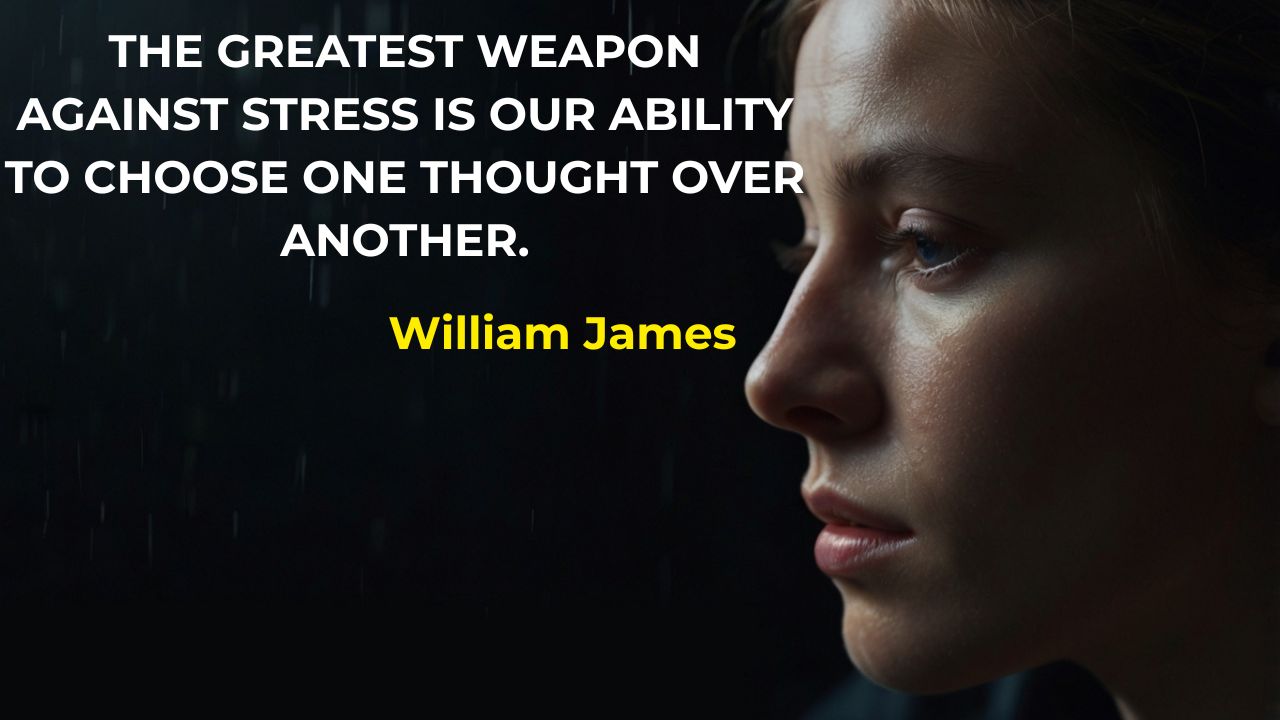Super User
The Science Behind Persistence
The Science Behind Persistence: How Your Brain Reacts to Challenges
Persistence is often seen as a mental trait—something that’s either inherent in you or learned over time. While it’s true that persistence involves elements like willpower and determination, there’s actually a lot of fascinating science behind how we persist in the face of challenges. Understanding the brain's role in persistence not only gives us deeper insight into our behavior but can also provide strategies to strengthen this critical skill.
In this article, we will dive into the neuroscience of persistence, exploring how our brain reacts to obstacles and how we can harness its power to overcome challenges.
The Neuroscience of Persistence
Persistence isn’t just a personality trait; it’s rooted in the brain’s ability to adapt, learn, and motivate us to continue pursuing long-term goals, despite setbacks. Let’s break down how different areas of the brain are involved in persistence:
1. **The Prefrontal Cortex: Your Brain’s Decision-Making Center**
The prefrontal cortex (PFC) plays a crucial role in persistence. It is the area of the brain responsible for higher cognitive functions, such as decision-making, planning, and regulating emotions. The PFC helps you assess your goals, weigh the costs and benefits of different actions, and control impulsive behaviors.
When facing an obstacle, the PFC helps you make rational decisions about how to move forward. It allows you to evaluate whether the challenge is worth pursuing, despite the difficulties. In this way, the PFC is essential for maintaining focus on long-term goals, even in the face of short-term obstacles.
For instance, when you decide to stay focused on a difficult project instead of giving in to distractions, your prefrontal cortex is working overtime to keep you engaged and on task. Over time, exercising this cognitive function can strengthen your ability to persist in the face of adversity.
2. **The Amygdala: The Brain’s Emotional Center**
The amygdala is often referred to as the brain's emotional processing center. It helps regulate emotional responses, particularly those related to fear and stress. While this part of the brain is essential for survival, it can sometimes be a hindrance when it comes to persistence.
When faced with challenges or setbacks, the amygdala often triggers the body’s stress response. This is a natural reaction designed to help us cope with danger or threat. However, in non-threatening situations—such as tackling a tough project or pursuing a long-term goal—this stress response can hinder our ability to push forward.
Persistent individuals have learned how to regulate their emotional reactions and override the amygdala’s impulse to retreat when faced with stress. This regulation typically happens in the prefrontal cortex, where rational thinking takes precedence over emotional impulses. Over time, we can train our brain to better manage stress and anxiety, allowing us to stay focused on our goals rather than being sidetracked by fear or discouragement.
3. **Dopamine: The Motivation Molecule**
Dopamine is a neurotransmitter that plays a key role in motivation, reward, and learning. It is often referred to as the "feel-good" chemical because it is released when we experience something pleasurable, such as achieving a goal or completing a task. Dopamine not only makes us feel good, but it also reinforces behaviors by encouraging us to repeat actions that lead to positive outcomes.
When we persist in the face of obstacles, our brain rewards us with small bursts of dopamine, which fuels our continued effort. The more we experience these rewards—whether through achieving small goals or simply progressing toward a larger one—the more motivated we become.
In fact, research has shown that individuals who experience a consistent flow of dopamine tend to show higher levels of persistence. This is why celebrating small wins along the way is so important. By acknowledging your progress, you activate the brain’s reward system, which motivates you to keep pushing forward, even when the final goal feels far away.
4. **The Role of Stress Hormones: Cortisol and Resilience**
When you face a stressful situation, your body releases cortisol, the primary stress hormone. While cortisol is necessary for helping us respond to immediate threats, prolonged exposure to high levels of stress can be detrimental to our physical and mental health, reducing our ability to stay persistent.
However, research has shown that individuals who build resilience to stress are better able to manage cortisol levels and maintain persistence. Resilience involves learning how to cope with and recover from stress, which enables you to stay focused on your long-term goals.
By practicing stress-reducing techniques like mindfulness, meditation, or physical exercise, you can help lower cortisol levels and enhance your ability to persevere through difficult times. This process of learning to manage stress not only improves your mental health but also boosts your brain’s capacity for persistence.
The Power of Neuroplasticity in Building Persistence
One of the most exciting aspects of the neuroscience behind persistence is neuroplasticity—the brain’s ability to reorganize and form new connections throughout life. Neuroplasticity means that the brain isn’t static; it can adapt and change in response to our experiences and behaviors.
When you consistently practice persistence—whether through setting long-term goals, managing stress, or exercising self-control—your brain strengthens the neural pathways associated with these behaviors. Over time, these pathways become more efficient, making it easier for you to stay focused and motivated in the face of challenges.
In essence, persistence is a skill that can be developed. The more you practice resilience, manage stress, and focus on your goals, the stronger your brain’s ability to persist will become. Neuroplasticity makes it possible to rewire your brain, shifting your default response to obstacles from one of avoidance to one of perseverance.
How to Strengthen Your Persistence: Practical Tips
Now that we understand the science behind persistence, how can we apply this knowledge to strengthen our own ability to persist? Here are some practical tips to enhance your persistence:
1. **Set Clear, Achievable Goals**
Break down your long-term goals into smaller, more manageable tasks. This makes it easier to stay motivated and helps you experience the dopamine-driven rewards of success more frequently.
2. **Practice Stress Management Techniques**
Incorporate mindfulness, meditation, or breathing exercises into your daily routine to reduce cortisol levels and build emotional resilience. This will allow you to stay calm and focused when challenges arise.
3. **Celebrate Small Wins**
Reward yourself for progress, no matter how small. Each step forward activates dopamine and reinforces the persistence cycle.
4. **Build a Support System**
Surround yourself with supportive people who encourage you and provide positive reinforcement. Social support is a powerful tool in helping you persist through difficulties.
5. **Embrace Failure as Feedback**
When setbacks happen, view them as learning opportunities. Reframe failure as a necessary part of the growth process and use it to adjust your approach.
Conclusion: Your Brain’s Capacity for Persistence
Persistence is not just a trait that some people are born with—it’s a skill that can be developed through understanding how your brain works. By leveraging the power of the prefrontal cortex, managing stress through emotional regulation, harnessing dopamine for motivation, and practicing resilience, you can strengthen your persistence over time.
With practice, persistence becomes a mental muscle that enables you to push through obstacles, stay focused on your goals, and achieve long-term success. Understanding the science behind persistence empowers you to take control of your actions, rewire your brain, and continue moving forward—even when the path is difficult. The more you build your persistence, the easier it becomes to tackle life's challenges and emerge stronger on the other side.
Overcoming Obstacles
Overcoming Obstacles: How Persistence Helps You Push Through Challenges
In life, obstacles are inevitable. Whether you’re pursuing a dream, growing your career, or trying to improve your personal health, you’ll undoubtedly encounter difficulties along the way. The difference between those who succeed and those who don’t often comes down to one key quality: persistence.
Persistence is the ability to keep going despite facing setbacks, difficulties, or failures. It’s about having the grit to continue moving forward, even when the path seems unclear or challenging. In this article, we’ll explore how persistence helps you push through obstacles, how it shapes your journey toward success, and why it's so crucial to achieving your long-term goals.
The Nature of Obstacles
Obstacles are a natural part of any journey. They can come in many forms: external challenges like financial difficulties, physical barriers like health issues, or internal struggles like self-doubt, fear of failure, or lack of confidence. No matter how well-prepared you are, obstacles will arise—they’re an inevitable part of growth.
However, obstacles don’t have to derail your progress. In fact, they can be opportunities for growth and learning, if you approach them with the right mindset. It’s how you respond to these obstacles that will ultimately determine your success.
Why Persistence is Crucial for Overcoming Obstacles
Persistence is a form of mental and emotional strength that allows you to maintain focus and effort, even when faced with difficulties. Here's why persistence is so crucial when overcoming obstacles:
1. Turning Setbacks into Learning Opportunities
When we encounter an obstacle, the natural response might be to feel defeated or frustrated. However, persistence encourages a shift in mindset—from viewing setbacks as failures to seeing them as valuable learning experiences. Persistent individuals don’t let setbacks define them; instead, they analyze what went wrong, adjust their strategy, and move forward with newfound wisdom. This ability to learn from setbacks allows you to grow and improve with each obstacle you face.
For example, many successful entrepreneurs have faced repeated failures before finding the right formula for success. Rather than giving up, they used each failure as an opportunity to learn, grow, and refine their approach. Persistence allowed them to see beyond temporary setbacks and push forward toward their goals.
2. Building Resilience in the Face of Adversity
Persistence builds resilience—the ability to recover from difficulties. The more you push through obstacles and setbacks, the stronger your mental and emotional resilience becomes. This resilience helps you bounce back more quickly after facing challenges, and it enables you to keep moving forward with determination and confidence.
Life is full of challenges, both big and small. Resilient individuals are able to weather these challenges and continue their pursuit of goals, despite the difficulties that come their way. Persistence in the face of adversity strengthens your ability to manage stress, recover from setbacks, and maintain a positive attitude, even when the going gets tough.
3. Maintaining Long-Term Focus and Commitment
Success rarely happens overnight. Achieving long-term goals takes time, patience, and consistent effort. Persistence helps you stay committed to your goals, even when immediate results are not visible. It keeps you focused on the bigger picture, encouraging you to take small, meaningful steps every day that contribute to your larger vision.
For example, if your goal is to run a marathon, your first few weeks of training may be difficult, and progress may feel slow. However, persistence helps you stick to your training plan, even when progress seems minimal. Over time, those consistent efforts add up, and you begin to see improvements—both in your physical strength and your mental resilience. Persistence makes long-term success possible, even when progress is gradual.
4. Developing Problem-Solving Skills
Obstacles often require creative solutions. When you’re persistent, you keep searching for ways to overcome challenges, rather than giving up. This process encourages critical thinking and innovation. You become better at problem-solving because you’re constantly refining your approach in order to navigate the obstacles that come your way.
For instance, if a particular method you’re using to achieve your goal isn’t working, persistence will prompt you to try a different strategy, seek advice from others, or find new resources. With each challenge, you sharpen your ability to think outside the box and come up with solutions that move you closer to your goal.
How to Cultivate Persistence
While some people may seem naturally persistent, persistence is a skill that anyone can develop. Here are some strategies to help you cultivate persistence in your own life:
1. Set Clear, Realistic Goals
One of the most important aspects of persistence is having a clear sense of purpose. When you have a defined goal, it becomes easier to stay focused and motivated, even when obstacles arise. Break down your long-term goals into smaller, more manageable tasks to make the journey feel less overwhelming. Celebrate each small milestone to keep your momentum going.
2. Maintain a Positive Mindset
It’s easy to become discouraged when faced with obstacles, but maintaining a positive mindset helps you see challenges as opportunities, not threats. Practice self-encouragement and remind yourself of your past successes. Positive thinking strengthens your mental resilience and helps you stay motivated even in the face of difficulties.
3. Embrace Failure as Part of the Process
Failure is often seen as a setback, but in reality, it’s an integral part of the process of growth. Instead of avoiding failure or seeing it as a sign of weakness, learn to embrace it. Every failure brings valuable insights that help you improve and refine your approach. Persistence doesn’t mean avoiding failure—it means continuing to push forward despite it.
4. Create a Support System
Having a support system in place can make all the difference when facing obstacles. Surround yourself with people who encourage you, provide feedback, and help you stay accountable to your goals. Whether it’s friends, family, or mentors, having someone to lean on during tough times gives you the strength to keep going.
5. Practice Self-Compassion
Persistence requires mental and emotional stamina, and it’s important to be kind to yourself during the journey. If you encounter setbacks or moments of doubt, practice self-compassion. Acknowledge that it’s okay to face challenges and that you’re doing your best. Self-compassion helps you maintain a healthy mindset, which is essential for long-term success.
Conclusion: The Power of Persistence
Overcoming obstacles is an inevitable part of life, but it’s persistence that separates those who succeed from those who give up. When faced with challenges, persistence allows you to keep going, adapt to the situation, and turn setbacks into opportunities for growth. It’s the ability to keep moving forward, even when the road is tough, that ultimately leads to long-term success.
By cultivating persistence in your own life, you equip yourself with the mental strength and resilience necessary to tackle challenges, learn from failure, and achieve your goals. Remember, obstacles are not roadblocks—they are stepping stones that shape you into a stronger, more determined individual. Keep going, stay persistent, and you will see your efforts pay off in ways you never imagined.
The Role of Persistence in Achieving Long-Term Goals
The Role of Persistence in Achieving Long-Term Goals
In a world that values instant gratification and quick results, persistence often takes a backseat in conversations about success. Yet, when we look closely at the stories of those who achieve remarkable long-term goals—whether in business, sports, or personal development—there’s one common factor: **persistence**. The ability to remain committed to a goal, even when faced with obstacles, setbacks, and failures, is often the true differentiator between success and failure.
But what does persistence really mean? How does it contribute to achieving long-term goals? In this article, we will explore the vital role persistence plays in long-term success and how you can harness it to achieve your dreams.
What is Persistence?
Persistence is the ability to keep going despite difficulties, delay in achieving success, or repeated failure. It's about maintaining effort, focus, and determination even when immediate results are not forthcoming. It’s the quality that pushes individuals to keep moving forward, even when the journey becomes tough.
Persistence is often compared to endurance—it’s not about quick wins or bursts of effort, but about consistently showing up day after day, working toward a larger vision. While talent, luck, or timing may play a role in success, persistence is the engine that powers sustained progress.
Persistence vs. Motivation: The Key Difference
While motivation is important, it can often be fleeting. Motivation comes in waves—there are times when you feel inspired and ready to tackle your goals, and other times when the excitement fades and distractions creep in. This is where persistence shines.
Persistence doesn’t rely on motivation to drive forward. It’s about making the decision to keep going regardless of how you feel in the moment. It’s about establishing habits and routines that continue even when motivation wanes. Think of persistence as the fuel for the journey, ensuring that you continue to move forward—even on days when you don’t feel like it.
The Role of Persistence in Long-Term Goals
Achieving long-term goals requires more than just short bursts of effort. It requires a **consistent commitment** to the process, regardless of the challenges that arise. Here are some of the ways persistence plays a crucial role in achieving long-term success:
1. **Overcoming Setbacks and Failures**
Setbacks are an inevitable part of any journey. Whether you face financial struggles, personal challenges, or professional roadblocks, persistence helps you continue despite these obstacles. Rather than seeing failure as the end of the road, persistent individuals use failure as a learning opportunity, refining their approach and adapting their strategy to move forward.
For example, many successful entrepreneurs faced multiple failures before finding success. The key was their persistence—taking those failures in stride, learning from mistakes, and continuing to push forward.
2. **Building Habits and Routines**
Long-term success is largely about creating sustainable habits and routines that keep you moving toward your goals. Persistence helps you develop these habits, making them part of your daily life. Small, consistent actions over time lead to significant results.
Whether it’s working on a creative project every day, exercising regularly, or dedicating time to study, the routine you establish through persistence will eventually become second nature. Over time, this consistency builds momentum and accelerates your progress.
3. **Staying Focused on the Big Picture**
Long-term goals, such as running a marathon, writing a book, or starting a successful business, require a lot of time and effort. The process can feel overwhelming at times. Persistence helps you stay focused on the bigger picture, reminding you why you’re putting in the effort.
When things get tough, persistence allows you to focus on the ultimate goal rather than getting bogged down by temporary challenges. It helps you see beyond the short-term discomforts and focus on the long-term rewards that are waiting for you.
4. **Adapting and Evolving**
Persistence isn’t just about mindlessly pushing forward; it’s about adapting and evolving along the way. As you continue working toward your goals, new information, experiences, and challenges will emerge. Persistence allows you to keep going while adjusting your approach when necessary.
Persistent individuals are often flexible and open to change. They know that they may need to adjust their strategy or try new methods to overcome obstacles, but they don’t give up. They keep adapting and evolving, never losing sight of their ultimate goal.
How to Cultivate Persistence
Persistence is not an innate trait—it’s a skill that can be developed and strengthened over time. Here are some strategies to help you cultivate persistence in your own life:
1. **Set Clear, Achievable Goals**
Breaking down your long-term goals into smaller, manageable tasks makes the journey feel less overwhelming. Setting clear, achievable milestones helps you stay focused and motivated. Each small accomplishment builds momentum, reinforcing your commitment to the bigger goal.
2. **Create a Plan and Stick to It**
Persistence thrives on structure and routine. Once you’ve set your goals, create a plan that outlines the steps needed to achieve them. By sticking to your plan, you’re building the discipline necessary to keep going, even when it feels difficult.
3. **Develop a Strong ‘Why’**
Understanding why you want to achieve your goal can provide powerful motivation during tough times. When you have a strong, clear reason behind your goal, you’ll be more likely to keep going, even when progress feels slow.
4. **Embrace the Process**
Success is often the result of small, incremental improvements. Rather than fixating solely on the end goal, embrace the process and enjoy the journey. Each day of work, each step you take, is a valuable part of the overall picture.
5. **Stay Resilient in the Face of Setbacks**
Setbacks are inevitable, but they don’t define your success. Developing resilience—the ability to bounce back from challenges—is an important aspect of persistence. When setbacks occur, treat them as opportunities to learn, adjust your approach, and keep moving forward.
Conclusion: Persistence as the Key to Long-Term Success
Persistence is not just about stubbornly pushing forward without considering other options; it’s about the strength to keep going despite adversity, setbacks, and doubts. It’s about developing habits that sustain progress, staying focused on long-term goals, and adapting to the challenges along the way. In a world that often celebrates quick fixes and instant success, persistence is the key to truly achieving meaningful, long-term goals.
By cultivating persistence, you equip yourself with the mindset and tools necessary to overcome obstacles and reach your dreams. Remember, success is not just about how fast you get there—it’s about how many times you rise after falling. Keep going, stay persistent, and trust that every step you take brings you closer to your ultimate goal.
The Art of Saying NO
The Art of Saying No: How Self-Control Leads to Healthier Choices
In our fast-paced world, where we’re constantly bombarded with demands, opportunities, and temptations, learning to say "no" is a powerful skill that can significantly improve our lives. From overcommitting to too many responsibilities to giving in to unhealthy food cravings, saying yes too often can lead to burnout, stress, and poor health. Self-control is at the heart of this art of saying "no"—it allows us to make choices that align with our values, protect our well-being, and create the space for what truly matters.
In this article, we’ll explore why saying no is essential for maintaining balance in our lives, how self-control plays a critical role in this process, and practical tips for mastering this important skill.
Why Saying No is Important
Saying "no" isn’t about being rude or shutting down opportunities; it’s about setting boundaries that protect your time, energy, and focus. In a world that glorifies busyness and constant availability, we can often feel compelled to say yes to every request or invitation that comes our way, even if it doesn't align with our goals or needs. However, constantly saying yes can lead to:
1. Burnout: Taking on too many tasks or responsibilities can overwhelm us and leave us physically, mentally, and emotionally drained. Resisting the urge to say yes all the time allows us to maintain energy and focus for what really matters.
2. Poor Health: Giving in to temptations like junk food, excessive drinking, or overworking can harm our health. Saying no to unhealthy habits or choices is a vital part of self-control and maintaining a healthy lifestyle.
3. Lack of Focus: Saying yes to everything can scatter our attention and make it harder to focus on our most important priorities. Saying no allows us to direct our attention and effort toward our core goals.
4. Stress: When we overextend ourselves by saying yes to every request, we increase our stress levels. Saying no reduces unnecessary pressure and helps us manage our commitments more effectively.
The Role of Self-Control in Saying No
Self-control is the ability to regulate our impulses, emotions, and behaviors in the face of temptations or distractions. It is an essential part of making healthier choices and setting boundaries. Here's how self-control supports the art of saying no:
1. Resisting Impulses: In many situations, we face immediate temptations or urges to say yes. For example, we might be invited to an event that clashes with an important personal goal, or we might feel compelled to buy unhealthy food because it’s available. Self-control helps us resist these impulses and make choices that are in line with our long-term well-being.
2. Prioritizing What Matters: Self-control allows us to be deliberate in our decision-making. Instead of automatically saying yes, we take a step back and evaluate whether the request aligns with our values, priorities, and long-term goals. By exercising self-control, we learn to say no to things that don’t serve us.
3. Managing Overwhelm: When faced with multiple requests or commitments, self-control helps us manage our resources—time, energy, and attention. We recognize that we can’t do everything, and by saying no to some things, we free up space for what truly matters.
4. Strengthening Boundaries: Resisting the urge to say yes is a powerful form of boundary-setting. By saying no, we send a message to others (and ourselves) that we respect our time and needs. This strengthens our personal boundaries and helps prevent burnout and resentment.
Practical Tips for Mastering the Art of Saying No
Saying no can feel uncomfortable at first, especially if you're used to people-pleasing or fear disappointing others. However, learning to say no is a key skill for healthier living and stronger self-control. Here are some practical strategies to help you say no with confidence:
1. Know Your Priorities
The first step in saying no is knowing what matters most to you. When you’re clear on your priorities, it becomes easier to determine what requests or invitations align with your values and goals. Take time to identify your personal, professional, and health-related priorities so that you can confidently assess whether a new request fits into your life.
2. Practice Mindfulness
Mindfulness helps you become more aware of your impulses and emotional responses. When faced with a request, take a moment to pause and reflect before making a decision. Ask yourself questions like:
• Does this align with my goals?
• Am I saying yes out of obligation or genuine interest?
• Do I have the time and energy for this?
Taking a mindful pause gives you the clarity to say no when needed.
3. Use a Polite but Firm Response
When you do say no, be respectful and clear in your response. You don’t have to over-explain yourself. A simple, firm yet polite response will suffice:
◇ "Thank you for thinking of me, but I have to decline."
◇ "I’m currently focused on other priorities, so I can’t commit to this right now."
◇ "I’m unable to take on any more commitments at this time."
You don’t owe anyone an elaborate explanation—just a kind and firm refusal.
4. Set Clear Boundaries
Setting boundaries is key to saying no. Be proactive in communicating your limits with others. For example, if you don’t want to take work calls after 6 PM, make it clear to colleagues that you’re unavailable during those hours. Establishing boundaries ahead of time prevents last-minute requests from becoming overwhelming.
5. Learn to Prioritize Your Own Well-Being
Saying no isn’t just about avoiding stress or overcommitment—it’s also about making sure that you’re caring for your own well-being. If a request or invitation interferes with your self-care routine, health goals, or personal time, it’s okay to decline. Prioritizing your own needs is an act of self-love, and you’ll be better equipped to help others when you take care of yourself first.
6. Practice Saying No
Like any skill, the more you practice saying no, the easier it becomes. Start small by saying no to minor requests, such as declining an invitation to a non-essential event or turning down an unnecessary purchase. As you build confidence, you’ll be able to say no to bigger commitments with ease.
Benefits of Saying No
Mastering the art of saying no brings numerous benefits to your life, including:
◇ Better Time Management: Saying no helps you prioritize tasks that are more important to your long-term success.
◇ Reduced Stress: With fewer commitments, you’ll experience less pressure and anxiety.
◇ Improved Health: Saying no to unhealthy temptations and distractions allows you to focus on better habits that support your health goals.
◇ Increased Self-Respect: Setting boundaries and saying no strengthens your sense of self-worth and respect for your time and energy.
Conclusion
Saying no is a powerful tool that supports healthier choices, greater self-control, and a more balanced life. By learning to say no, you protect your time, your energy, and your well-being, ensuring that you have the resources to focus on what truly matters. While it may take practice, mastering the art of saying no will ultimately help you lead a more intentional, fulfilled, and healthier life. Remember, every time you say no to something that doesn’t serve you, you’re saying yes to yourself and your long-term goals.
The Power of Resilience
The Power of Resilience: Bouncing Back Stronger
Life is filled with challenges, setbacks, and unexpected twists. Whether it’s dealing with personal loss, facing professional difficulties, or navigating unforeseen obstacles, we all encounter moments when we feel overwhelmed. The difference between those who thrive and those who struggle in the face of adversity often boils down to one key trait: resilience.
Resilience is not just about bouncing back from hardship—it’s about growing stronger in the process, adapting to the situation, and emerging even more capable than before. In this article, we’ll explore the concept of resilience, why it’s crucial for success, and how you can develop and cultivate it in your own life.
What is Resilience?
Resilience is the ability to recover quickly from setbacks, adapt to difficult circumstances, and keep going in the face of adversity. It’s often described as “mental toughness” or “grit,” but it’s more than just enduring hardship. Resilience involves maintaining a positive mindset, learning from failure, and finding the strength to keep moving forward.
The truly resilient aren’t immune to stress or challenges; instead, they possess the ability to manage adversity with a mindset focused on growth. They see obstacles as opportunities for learning and are skilled at turning setbacks into stepping stones for greater achievement.
The Importance of Resilience
Resilience is essential for navigating the ups and downs of life. Whether it’s in your career, relationships, or personal development, resilience allows you to face challenges head-on and find a way forward. Here are a few reasons why resilience is crucial:
1. Overcoming Challenges
Life is unpredictable, and no one is exempt from hardship. Resilience enables you to persevere through tough times, whether it’s dealing with a job loss, going through a breakup, or facing a health scare. It helps you push forward, even when the road ahead seems unclear.
2. Emotional Strength
When faced with adversity, resilient individuals are able to manage their emotions effectively. Instead of being overwhelmed by negative emotions like anger, sadness, or fear, they’re able to process these feelings and maintain control over how they respond to situations.
3. Adaptability
Resilience doesn’t just mean enduring stress—it’s about adapting to new circumstances. Life’s challenges often require us to shift our thinking, behavior, or approach. Resilient people are flexible and open to change, knowing that growth comes from the ability to pivot and adjust when needed.
4. Long-Term Success
Success is rarely a straight line. Setbacks and failures are a part of any journey. However, resilient individuals understand that setbacks don’t define them. Instead of quitting or losing motivation, they use failures as learning experiences, which propels them toward future success.
The Science of Resilience
While resilience may seem like a “soft” concept, it’s actually rooted in science. Research in psychology and neuroscience has shown that resilience involves several key components:
1. Cognitive Flexibility
Resilience involves the ability to adapt to new and challenging situations. This flexibility is rooted in how we think. Resilient individuals are often better at reframing negative thoughts, seeing challenges as temporary, and finding positive ways to think about setbacks. This cognitive flexibility allows them to handle stress in a healthier way.
2. Emotional Regulation
Emotionally resilient individuals are skilled at managing their emotions. Instead of being overwhelmed by negative feelings, they acknowledge their emotions and take constructive actions to deal with them. This emotional regulation is important for making clear decisions and remaining calm under pressure.
3. Social Support
Research shows that resilient people often have strong support systems—whether it’s family, friends, or mentors. Social support plays a vital role in resilience by providing encouragement, perspective, and practical help during tough times.
4. Purpose and Meaning
Having a sense of purpose is another important factor in resilience. People who feel connected to a greater purpose or who have meaningful goals are better able to overcome challenges. This sense of purpose gives individuals the drive to keep moving forward, even when the going gets tough.
How to Build Resilience
Resilience is not something you’re born with—it's a skill that can be developed over time. Just like building physical strength in the gym, strengthening your resilience requires consistent effort and practice. Here are some strategies to help you build resilience:
1. Develop a Growth Mindset
A growth mindset is the belief that abilities and intelligence can be developed through hard work, perseverance, and learning. Resilient people see failure as an opportunity to learn, not as a reflection of their abilities. When faced with challenges, focus on what you can learn and how you can grow from the experience.
2. Take Care of Your Mental and Physical Health
Resilience thrives when your body and mind are in good shape. Exercise regularly, eat a balanced diet, and get enough sleep. Practices like mindfulness meditation, journaling, or deep breathing can help reduce stress and improve emotional resilience.
3. Cultivate a Positive Outlook
A key element of resilience is maintaining a positive mindset. This doesn’t mean ignoring the difficulties you face, but rather choosing to focus on what you can control and the positives in your life. Practice gratitude by reflecting on what you’re thankful for, even in tough times. It’s a simple yet powerful way to build emotional resilience.
4. Set Realistic Goals
Setting achievable goals helps you stay focused and motivated. Break your long-term goals into smaller, manageable steps. This gives you a sense of control over your progress, boosts your confidence, and makes it easier to adapt to setbacks without losing motivation.
5. Build Strong Relationships
Having a support system is crucial in building resilience. Surround yourself with people who uplift and encourage you. Invest in your relationships with family, friends, and colleagues, and don’t be afraid to reach out for help when needed. Having a strong network gives you the emotional support you need to bounce back from difficulties.
6. Embrace Change
One of the key elements of resilience is adaptability. Life will inevitably throw curveballs your way, but the more you embrace change and see it as an opportunity to learn, the stronger your resilience will become. Cultivate flexibility in your approach to challenges, and be open to new possibilities.
7. Learn to Manage Stress
Chronic stress can wear down your resilience. To manage stress effectively, practice relaxation techniques like yoga, mindfulness, or deep breathing. Taking breaks during stressful periods and learning how to disconnect can also help prevent burnout and enhance your ability to cope with challenges.
Conclusion: Resilience is a Lifelong Journey
Resilience is not a fixed trait; it’s something that can be cultivated and strengthened over time. It’s the ability to bounce back from adversity, learn from failure, and grow stronger with each challenge. Resilient people are able to face life’s ups and downs with grace, adaptability, and perseverance.
By developing a growth mindset, taking care of your mental and physical health, and building a strong support system, you can strengthen your own resilience and face life’s challenges with confidence. Remember, resilience is not about avoiding hardships—it’s about how you handle them, learn from them, and continue moving forward. The more resilient you become, the more you’ll realize that setbacks are simply stepping stones on your path to success.
From Impulse To Action
From Impulse to Action: How to Strengthen Your Self-Control Muscles
In a world full of distractions and temptations, maintaining self-control is a key component of personal success. Whether you’re trying to stick to a healthy diet, complete a work project, or simply avoid procrastination, mastering your impulses and transforming them into focused action can have a profound impact on your life. But how do you shift from acting on impulse to acting with intention? Like any skill, self-control can be strengthened and cultivated over time with practice. Let’s explore how you can build and reinforce your self-control muscles to achieve your long-term goals.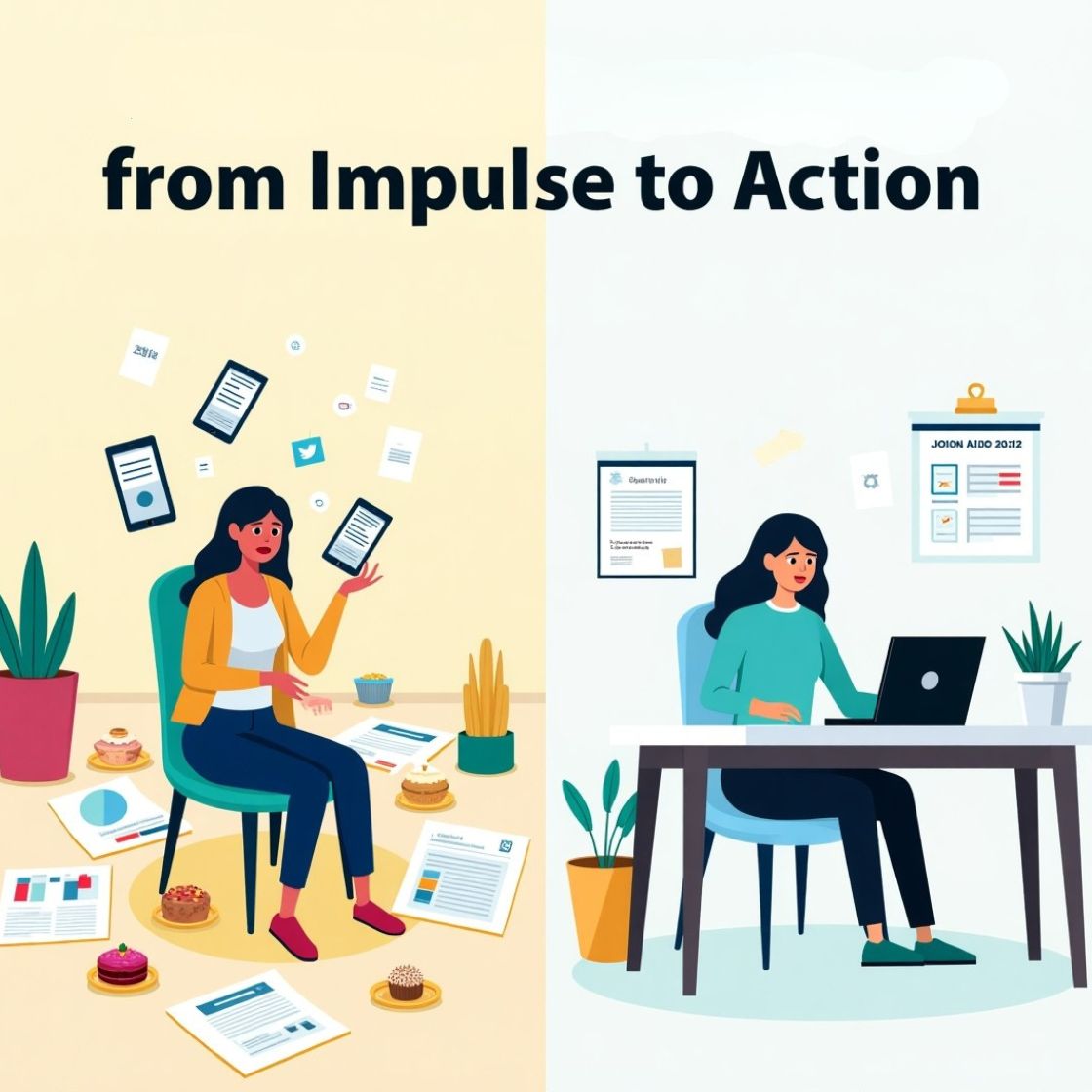
Understanding Self-Control: What Does It Really Mean?
Self-control is the ability to regulate your thoughts, emotions, and behaviors in the face of temptations or impulses. It's about making choices that align with your long-term goals rather than being swayed by immediate desires or distractions. Think of self-control like a muscle. The more you use it, the stronger it gets. When you develop strong self-control, you are more likely to achieve success, maintain healthy habits, and make decisions that benefit your future.
On the other hand, lack of self-control can lead to habits that undermine your efforts, whether it's eating junk food when you want to get healthier, procrastinating when you should be working, or engaging in behaviors that don’t align with your values. The good news is that self-control can be trained, and you can go from being impulsive to being deliberate in your actions.
Step 1: Understand Your Impulses
The first step to strengthening your self-control muscles is to understand your impulses. Impulses are often quick, emotional reactions to something in the environment—like a craving for chocolate or the desire to check social media when you should be focusing on a task.
Ask yourself these questions:
• When do I give in to impulsive behaviors?
• What triggers these impulses?
• How do I feel immediately after giving in to these impulses?
Recognizing the triggers that prompt your impulses can help you understand your behavior and start to work on redirecting it. This step is crucial because without understanding where your impulses come from, it’s difficult to make intentional decisions that align with your goals.
Step 2: Practice Mindfulness and Delay Gratification
One of the most effective strategies to develop self-control is practicing mindfulness. Mindfulness helps you become more aware of your emotions and thoughts in the moment. This awareness allows you to pause before reacting to an impulse and make a conscious decision about how to respond.
One powerful way to practice mindfulness is through delayed gratification. Instead of immediately giving in to a desire (like checking your phone or eating a piece of cake), try delaying the action for a set period of time—say, 10 minutes. This gives you a moment to think about your long-term goals and evaluate whether acting on impulse aligns with those goals.
For example, if you’re trying to stick to a diet and crave a sugary snack, instead of instantly reaching for it, take a few deep breaths, drink some water, or go for a walk. Often, by the time the 10 minutes are up, the impulse will have passed, and you’ll feel more empowered to stick to your decision.
Step 3: Break Down Big Goals into Smaller, Manageable Tasks
Self-control can be especially challenging when you're working toward long-term goals that seem far away. The further away a goal is, the easier it is to give in to impulses that offer instant rewards. By breaking down your goals into smaller, more manageable tasks, you make progress feel more immediate and achievable.
For instance, if your goal is to write a book, the thought of completing an entire manuscript might feel overwhelming. Instead of focusing on the long road ahead, break the project down into smaller tasks—such as writing 500 words a day or working on a specific chapter. These smaller tasks are more concrete and easier to control, helping you avoid distractions and stay focused.
Step 4: Create an Environment That Supports Self-Control
Your environment plays a crucial role in helping you exercise self-control. The easier you make it to stay focused and the harder you make it to indulge in temptations, the more likely you are to practice self-control.
Here are a few ways to set yourself up for success:
◇ Remove distractions: If you’re working on an important project, turn off notifications, put your phone in another room, or use apps that block distracting websites.
◇ Set up a space for focus: Create a dedicated workspace free from clutter or distractions. Having a space that encourages productivity can help you resist temptations.
◇ Plan ahead: If you know you're prone to eating junk food when you're stressed, prepare healthy snacks in advance so you’re not tempted to indulge when the cravings hit.
The more you can shape your environment to support your goals, the easier it will be to act with intention rather than give in to impulsive behavior.
Step 5: Build Healthy Habits and Routines
Habits and routines are powerful tools for improving self-control. The more habitual a behavior becomes, the less energy and willpower it takes to carry out. When you make good choices regularly, they become automatic.
Start by focusing on one small habit that will help you build your self-control muscles. This could be something as simple as exercising for 10 minutes a day, drinking more water, or planning your meals in advance. Over time, these small, positive habits will begin to accumulate and become ingrained in your daily routine.
The key is to start small and be consistent. As you build momentum, you’ll find that self-control becomes easier, and resisting temptations feels more natural.
Step 6: Strengthen Your Self-Control with Practice
Just like any skill, self-control requires practice. It’s important to give yourself grace when you slip up and to view setbacks as opportunities to learn rather than failures. Strengthening your self-control muscles is a journey, not a destination.
Setbacks are inevitable, but with each challenge, you’ll become more aware of your impulses and better equipped to handle them. The more you practice, the easier it becomes to delay gratification, make intentional decisions, and achieve your long-term goals.
Conclusion: From Impulse to Action
Self-control is not something that comes naturally to everyone, but it is a skill that can be developed. By understanding your impulses, practicing mindfulness, breaking down big goals, and creating an environment that fosters discipline, you can strengthen your self-control muscles and move from impulsive reactions to deliberate action. With practice and perseverance, you will develop the ability to control your impulses and act in ways that bring you closer to your dreams.
The path to mastering self-control isn’t easy, but the rewards—greater focus, better decisions, and long-term success—are well worth the effort. Start small, stay consistent, and over time, you’ll find yourself taking action in alignment with your goals, not your impulses.
Self-Control vs Self-Sabotage
Self-Control vs. Self-Sabotage: How to Stop Undermining Your Goals
In the pursuit of personal growth and success, one of the biggest challenges we face is managing our own behaviors. Often, we are our own worst enemies. Self-sabotage is a common hurdle many encounter—whether it’s procrastination, negative self-talk, or impulsive actions that derail progress. The struggle between self-control and self-sabotage can be intense, but understanding this dynamic is the first step toward overcoming it and achieving your goals.
What is Self-Sabotage?
Self-sabotage is when we consciously or unconsciously engage in behaviors that hinder our success. These actions work against the goals we have set, and often, we don't realize we're sabotaging ourselves until we see the negative results. It could be procrastinating on an important project, choosing instant gratification over long-term success, or allowing negative thoughts to take over, leading to a lack of motivation.
While self-sabotage may seem like an insurmountable obstacle, it’s important to remember that these behaviors often stem from deeper feelings like fear of failure, insecurity, or a lack of self-worth. These emotions may trick us into thinking that we’re protecting ourselves from disappointment or that avoiding the task is a way to avoid failure.
How Self-Control Helps You Avoid Self-Sabotage
On the other side of the spectrum, self-control is the ability to regulate your emotions, thoughts, and behaviors in the face of temptations and impulses, and it’s critical for overcoming self-sabotage. It involves making choices that align with your long-term goals, rather than giving in to short-term urges. Self-control doesn’t mean denying yourself pleasure or relaxation; rather, it’s about balancing your desires with your broader objectives, ensuring that you make decisions that move you forward instead of holding you back.
The Conflict: Why Do We Self-Sabotage?
The answer lies in the psychology of human behavior. While we consciously desire success and growth, our subconscious mind may feel threatened by the unknowns or difficulties that come with pursuing our goals. For example:
1. Fear of Failure: We may sabotage our own efforts to protect ourselves from the fear of failing. By not even trying, we avoid the potential pain of rejection or disappointment.
2. Low Self-Worth: If we don't believe we deserve success, we may make choices that keep us stuck in mediocrity.
3. Comfort in the Familiar: Even if it’s unhealthy, the comfort of familiar habits can be easier than breaking through the discomfort of change.
4. Instant Gratification: Often, the lure of immediate pleasure outweighs the long-term benefits of staying on track. We might choose short-term rewards (like binge-watching TV or eating junk food) instead of focusing on the bigger picture.
Recognizing these behaviors is key to changing them. By acknowledging that self-sabotage often arises from fear, insecurity, or the comfort of routine, we can begin to address these issues and work toward healthier, more productive habits.
How to Stop Self-Sabotage and Strengthen Self-Control
1. Recognize the Signs of Self-Sabotage The first step is to identify when you are sabotaging yourself. Pay attention to patterns like procrastination, self-doubt, or avoidance. When you catch yourself in the act, take a step back and examine the underlying thoughts or emotions driving those behaviors.
2. Set Clear, Achievable Goals Often, self-sabotage arises from the feeling of being overwhelmed. If your goals are too vague or unrealistic, it’s easy to put them off or avoid them altogether. Break your larger goals into smaller, achievable tasks, and focus on completing one small step at a time.
3. Replace Negative Thought Patterns Negative self-talk is one of the most common forms of self-sabotage. When you catch yourself thinking, “I’ll never be able to do this” or “I’m not good enough,” challenge those thoughts. Replace them with more empowering, positive affirmations like, “I am capable,” or “Every small step brings me closer to my goal.”
4. Practice Mindfulness and Emotional Awareness Mindfulness is a powerful tool for self-control. By being aware of your emotions and impulses in the moment, you can make more intentional choices. When you feel the urge to procrastinate or indulge in unhealthy habits, take a few deep breaths, and check in with yourself. Ask, “What do I really want right now? What will help me achieve my long-term goals?”
5. Reward Yourself for Small Wins Self-control doesn't mean denying yourself rewards altogether. Celebrate your small victories and milestones. Positive reinforcement can help build momentum and increase your motivation to stay on track.
6. Develop Healthy Habits Often, self-sabotage occurs because we’ve formed unhealthy habits over time. The good news is, habits can be changed. By consciously replacing negative habits (like procrastination or unhealthy eating) with positive ones (like setting aside time for focused work or cooking nutritious meals), you begin to shift your behavior and reinforce self-control.
7. Visualize Your Success Picture yourself succeeding. Visualization can boost your motivation and strengthen your resolve. See yourself accomplishing your goals, enjoying the benefits of your hard work, and living the life you want. This imagery can keep you focused and motivated to avoid self-sabotaging behaviors.
8. Seek Support and Accountability Sometimes, we need others to help us stay on track. Whether it’s a mentor, a coach, or a friend, having someone to hold you accountable can make a big difference in reducing self-sabotage. Share your goals and progress with them, and let them help you stay motivated.
9. Be Kind to Yourself Finally, practice self-compassion. We all make mistakes and experience setbacks. Instead of beating yourself up when things don’t go as planned, treat yourself with kindness. Learn from your mistakes and keep moving forward. Self-compassion helps prevent the guilt and shame that often lead to further self-sabotage.
Conclusion
Self-sabotage can feel like a powerful force working against your goals, but it’s important to remember that self-control is an even more powerful tool. By recognizing the ways you undermine your own success and taking steps to strengthen your self-control, you can break free from this cycle. Practice mindfulness, challenge negative thought patterns, and build healthier habits to keep yourself on track. Self-sabotage might try to hold you back, but with determination and self-control, you have the power to reach your goals and unlock your full potential.
Understanding Self-Sabotage
Understanding Self-Sabotage: The Hidden Barrier to Our Success
Self-sabotage is one of the most destructive patterns we can fall into, but it often operates beneath the surface of our conscious awareness. In the image above, we see a person sitting at a desk late at night, visibly stressed and overwhelmed. The setting is chaotic—a mix of unfinished food, a bottle of water, a phone with notifications, and scattered papers. This visual captures the essence of self-sabotage: we often say we want something, but then take actions that prevent us from achieving it.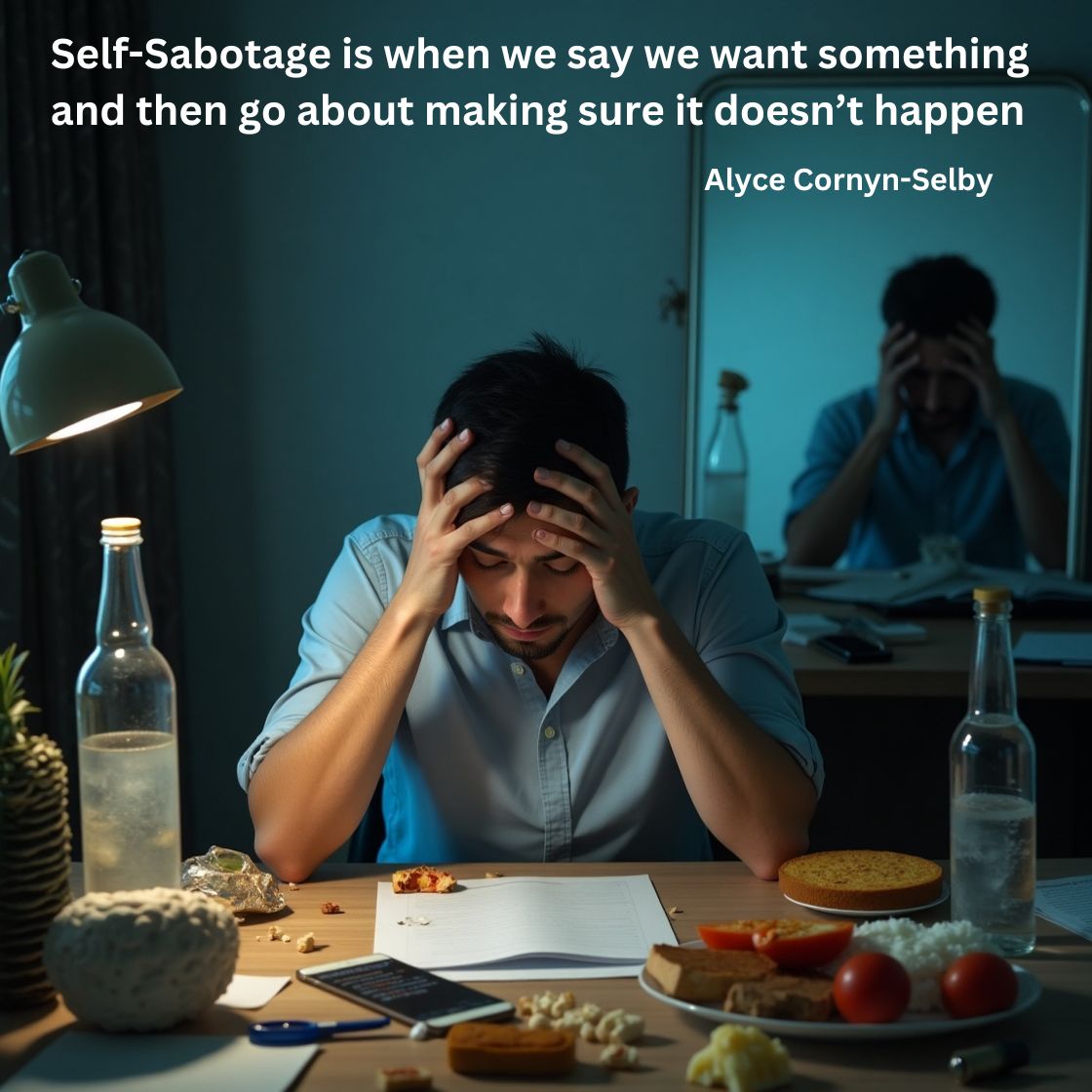
As the quote from Alyce Cornyn-Selby in the image states, "Self-sabotage is when we say we want something and then go about making sure it doesn’t happen." This powerful statement perfectly captures the paradox of self-sabotage—our actions directly contradict our desires.
What Is Self-Sabotage?
Self-sabotage refers to behaviors or thought patterns that prevent us from reaching our goals. These actions are often unconscious and can manifest in various ways, such as procrastination, negative self-talk, unhealthy habits, or avoiding opportunities that could lead to success. It’s a paradoxical cycle where, despite our best intentions, we undermine ourselves, often because of fear, insecurity, or a lack of belief in our abilities.
In the image, the person is surrounded by distractions: food and drink, a phone with potential distractions, and a disorganized workspace. This chaotic environment can be a physical manifestation of the inner turmoil often experienced by someone engaging in self-sabotage. They may say they want to be productive or successful, but the actions they take—eating mindlessly, checking their phone, and avoiding the work at hand—ultimately keep them stuck.
Why Do We Self-Sabotage?
1. **Fear of Failure or Success**
Sometimes, we sabotage our own efforts because we’re afraid of failing. We fear that our efforts will not be enough or that others will judge us for not succeeding. But interestingly, there is also a deeper, more subtle fear of success. Success might bring added pressure, higher expectations, or unwanted changes in our lives. The fear of success can cause us to hold back, to procrastinate, or to make excuses—ultimately preventing us from reaching our full potential.
2. **Low Self-Worth**
A lack of self-esteem or self-worth can lead to self-sabotage. If we don't believe we deserve success, we may unintentionally take actions that prevent us from achieving our goals. This could look like procrastination, self-doubt, or avoiding opportunities that could lead to personal or professional growth.
3. **Comfort in the Familiar**
Humans tend to seek comfort in the familiar, even if it’s unhealthy. It’s easier to stay in a cycle of procrastination or to indulge in distractions than to face the discomfort of doing the hard work required to achieve a goal. The person in the image, for example, might be eating unhealthy food or drinking mindlessly instead of focusing on their tasks, simply because it feels better in the short term than facing the anxiety of work or responsibility.
4. **Perfectionism**
Perfectionism is another form of self-sabotage. When we set unattainably high standards for ourselves, we can become paralyzed by the fear of making mistakes. As a result, we procrastinate, avoiding the task entirely to prevent the possibility of not meeting our own expectations. This is reflected in the image—by sitting idly and stressing out, the person may be avoiding the task due to the fear of not doing it "perfectly."
The Cycle of Self-Sabotage
Self-sabotage often works in a vicious cycle. At first, we might feel motivated to achieve a goal, but as we face obstacles or discomfort, we begin to retreat into old habits or distractions. Over time, these actions reinforce feelings of guilt, frustration, and shame, which can make it even harder to break the cycle. In the image, the individual’s frustrated body language—holding their head in their hands—illustrates this internal struggle. The chaotic desk, the unfinished food, and the scattered papers represent the unfinished business that piles up when self-sabotage takes hold.
This cycle can continue unless we identify it and take steps to change our behavior.
Breaking the Cycle of Self-Sabotage
Recognizing that we are engaging in self-sabotage is the first step in breaking the cycle. Here are some strategies to help overcome it:
1. **Awareness and Mindfulness**
The first step to overcoming self-sabotage is to become aware of the behaviors and thought patterns that lead to it. Mindfulness practices—such as journaling or meditation—can help you reflect on your actions and notice when you are derailing your own success. Being aware allows you to intervene before the sabotage spirals out of control.
2. **Challenge Negative Beliefs**
If you struggle with feelings of low self-worth, challenge those beliefs. Replace negative self-talk with positive affirmations and focus on your strengths. Remember, you are capable of achieving your goals, and you deserve success.
3. **Set Achievable Goals**
Sometimes, self-sabotage occurs because the goals we set for ourselves feel too daunting or overwhelming. Break your larger goals down into smaller, manageable tasks. Celebrate each small win, and give yourself credit for progress, no matter how small.
4. **Create a Support System**
Having a support system of friends, family, or mentors can help you stay accountable and motivated. Sometimes, we need external encouragement to push through difficult moments and remind us of our potential.
5. **Take Care of Your Mental Health**
Self-sabotage often comes from unresolved anxiety, stress, or past trauma. Take care of your mental health by seeking therapy, practicing self-compassion, and engaging in healthy coping mechanisms. The healthier you feel mentally, the less likely you are to fall into self-sabotaging behaviors.
Conclusion
The image of the person engaging in self-sabotage—a common struggle in our journey to success—illustrates the complexity of this hidden behavior. While we may outwardly say we want something, our actions sometimes contradict our desires. The key to overcoming self-sabotage lies in recognizing it, understanding why we engage in it, and taking intentional steps to break the cycle. With awareness, determination, and support, we can stop undermining our own success and begin to take control of our future.
The Power of Persistence
The Power of Persistence: Why It’s More Important Than Talent
In the journey toward success, there’s often a misconception that talent or genius is the key to achieving greatness. While these attributes can certainly help, they are not enough on their own. As the famous quote from Calvin Coolidge suggests, "Nothing in this world can take the place of persistence."
This quote, highlighted in a beautiful setting of historical elegance, offers a profound insight into what truly matters in achieving long-term success: persistence and determination. In this article, we'll explore why persistence is so critical and how it surpasses talent, genius, and even education when it comes to realizing your goals.
The Setting of Persistence
The image accompanying this quote sets a dramatic and timeless atmosphere. It shows an ornate room with antique furniture, a clock, and a lit candle that suggests a passage of time. The words of Calvin Coolidge are displayed on an ancient-looking scroll, reinforcing the timeless truth that persistence is the ultimate key to success. The contrast between the richness of history and the simplicity of the message underscores how deeply embedded this wisdom is in the human experience.
The room’s formal, almost museum-like environment symbolizes how persistence is often overlooked or forgotten, despite being one of the most important virtues for success. In a world that often prizes talent, immediate success, and quick results, persistence can feel outdated or underappreciated. However, Coolidge’s words remind us that in the end, it is persistence that leads us to our goals.
Why Persistence Beats Talent
Talent is a wonderful gift, but it is not a guarantee of success. There are countless examples of individuals with immense talent who never reach their full potential due to a lack of perseverance. Talent might open doors, but it’s persistence that ensures you push through challenges, failures, and setbacks.
Coolidge points out that "Nothing is more common than unsuccessful men with talent." Talent can only take you so far. Without persistence, talent is like a spark that never fully ignites. Those who rely solely on their innate abilities often falter when they face difficulties. But those who persist, even in the face of adversity, can achieve remarkable success.
Genius Will Not: The Importance of Hard Work
Similarly, Coolidge emphasizes that "Genius will not; unrewarded genius is almost a proverb." Genius, like talent, can give you an edge, but it’s not the final ingredient for success. How many stories do we hear of people whose groundbreaking ideas or extraordinary intelligence go unnoticed or unappreciated because they lacked the persistence to see their ideas come to fruition?
Many brilliant minds have failed not because they were not capable, but because they gave up too soon. The key to turning genius into success lies in determination. The world is full of individuals who are talented or even genius-level but who never achieved success because they failed to persist in their efforts.
### Education is Not Enough
Coolidge doesn’t stop there. He makes another important point: "Education will not: the world is full of educated derelicts." Education is undeniably important, but it doesn’t guarantee success on its own. In today’s world, education is more accessible than ever, yet many highly educated individuals struggle to find success because they don’t have the grit to push through the inevitable obstacles of life.
Education equips us with knowledge, but persistence helps us apply that knowledge effectively, even when things aren’t going as planned. A well-educated person might know the theory of success, but it’s persistence that allows them to take action, learn from mistakes, and keep going despite challenges.
The Omnipotence of Persistence
Coolidge concludes with a powerful statement: "Persistence and determination alone are omnipotent." This emphasizes the idea that no matter your starting point, no matter how many times you fail, persistence is the ultimate force that can move you toward success.
Success is not determined by talent, intelligence, or education alone. It is the ability to keep going in the face of difficulty, to take consistent action despite setbacks, and to never give up on your goals. Whether you're an entrepreneur, an artist, an athlete, or anyone working toward a goal, persistence is the trait that will make the difference between success and failure.
How to Cultivate Persistence
Persistence isn’t something you’re born with; it’s something you can develop. Here are a few ways to cultivate persistence in your own life:
1. **Set Clear, Achievable Goals**: Break down your big goals into smaller, manageable tasks. This will help you stay focused and motivated, even when the journey feels long.
2. **Embrace Failure as Part of the Process**: Understand that failure is inevitable, but it’s also a valuable lesson. Learn from your mistakes, but don’t let them stop you from moving forward.
3. **Build a Support System**: Surround yourself with people who encourage and motivate you. Having a strong support system can make it easier to keep going when things get tough.
4. **Develop a Growth Mindset**: Believe that with effort and practice, you can improve. Stay committed to learning, growing, and evolving, no matter how difficult it gets.
5. **Stay Patient**: Success doesn’t happen overnight. Understand that persistence takes time, but the rewards are worth the effort.
Conclusion
Calvin Coolidge’s timeless message on the power of persistence reminds us that success isn’t about being the most talented, the smartest, or the most educated. It’s about having the determination to keep going even when the odds are stacked against you. In the end, persistence is the force that transforms talent, genius, and education into achievement. It is omnipotent—unstoppable and capable of overcoming any obstacle. So, the next time you’re facing a challenge, remember: keep going. Persistence is the true key to success.
The Perils of Turning Back Before Reaching Success
The Perils of Turning Back Before Reaching Success
In the journey toward achieving our dreams, we often face moments of doubt, fatigue, and uncertainty. The path to success is rarely a smooth, straight road. It’s filled with obstacles, challenges, and times when progress feels too slow or too hard. But sometimes, just when we are on the verge of success, we make the mistake of turning back too soon—right before the breakthrough happens.
This moment is perfectly captured in the image of a person climbing a mountain with a backpack filled with tools and supplies, with a signpost just ahead that reads “Success.” The sun is shining brightly, casting a hopeful glow over the person’s journey. However, despite being only a few steps away from reaching the summit, the person has turned around and is headed back down the path. This powerful image speaks to a common experience: we often give up right before reaching the goal.
The Journey to Success is Often Hardest Near the End
Reaching success is rarely easy, and it’s especially tough when the finish line is just within reach. When the going gets tough, it’s natural to question whether the effort is worth it. The climb seems exhausting, the challenges seem insurmountable, and the rewards appear distant. At times like these, we may feel tempted to give up, convinced that the struggle isn’t worth the outcome.
But the key to success lies in pushing through those moments of doubt. The image shows a person who has almost reached the top but turns back before experiencing the triumph of achieving their goal. Many people face similar moments in their lives. Whether it’s a business venture, a personal goal, or a relationship, the hardest part is often just before the breakthrough. It’s easy to quit when you don’t yet see the fruits of your labor, but persistence can often make all the difference.
The Dangers of Giving Up Too Soon
Turning back before reaching success can have significant consequences. Not only does it delay or derail your progress, but it also means missing out on the satisfaction that comes from overcoming adversity. In the image, the person is carrying a heavy load, and while the weight may feel burdensome, each step forward is an investment in achieving something worthwhile. However, by turning back, the person is not only missing out on the goal they sought, but also the learning and growth that happens along the way.
Here are some dangers of giving up too soon:
1. Lost Opportunity: Sometimes, we’re just a few steps away from success, but we can’t see it. By turning back, you might miss the very opportunity you’ve been working toward.
2. Regret: Walking away from a goal can lead to long-lasting feelings of regret. The “what ifs” can haunt us when we wonder what might have happened if we had stuck with it just a little longer.
3. Stagnation: Giving up means staying where you are. Progress only happens when you continue moving forward, even when it feels difficult.
How to Push Through the Tough Moments
If you find yourself in a situation where you’re tempted to give up—whether it’s a professional project, a personal dream, or a relationship—remind yourself that success is often just on the other side of your current struggle. Here are some strategies to help you push through:
1. Break the Task Into Smaller Steps**: If the goal seems overwhelming, break it down into smaller, more manageable steps. Each small victory brings you closer to the final destination.
2. Focus on the Why: Remember why you started this journey in the first place. Revisiting your motivation can reignite your passion and remind you of the value of persevering.
3. Rest, Don’t Quit: Sometimes, you need to take a short break to recharge. Resting doesn’t mean giving up—it means coming back stronger. Don’t confuse the need for a break with the need to quit.
4. Seek Support: Talk to someone who has been through a similar journey or who can offer encouragement. External support can provide perspective and strength when you feel like turning back.
5. Visualize the Finish Line: Picture yourself standing at the summit of your journey, looking back at how far you’ve come. Imagine the pride and satisfaction you’ll feel when you finally reach your goal. This vision can fuel your determination to keep moving forward.
Success is Often Just One Step Away
It’s easy to get discouraged, especially when the finish line feels distant or obscured by challenges. But the truth is, success often lies just beyond the most difficult moments. The person in the image is only a few steps away from reaching success, yet by turning back, they miss the chance to experience the rewards of their effort.
In life, we all face these pivotal moments—the moments when we’re about to give up, just as success is within reach. The next time you feel tempted to turn back, remember that you might be closer to your goal than you think. Stick with it, and take those final steps. Success might be just around the corner.
Conclusion
The image of the person turning back just before reaching success is a reminder of how easily we can give up right before the breakthrough. Success often comes after the hardest part of the journey. By recognizing the dangers of turning back too soon and pushing through the tough moments, we can reach our goals and experience the fulfillment that comes from persevering. Keep going, because success is often just one step away.
- Audio Articles
- Audio Articles 1
- Audio Articles 2
- Audio Articles 3
- Audio Articles 4

7 Daily Disciplines That Transform Your Life
The power to act with intention, to align your actions with your values, and to move steadily toward a life of purpose—even on days you don't feel like it.
Read Full Article
How to Build Unbreakable Discipline
Discipline is built—habit by habit, choice by choice, day by day. And the most powerful kind? The kind that doesn’t crack under pressure. The kind that becomes part of who you are.
Read Full Article
Why Motivation Fails And Discipline Wins Every Time
We all love the feeling of motivation—that surge of energy, that rush of inspiration that makes everything seem possible. But here’s the problem: motivation is unreliable. It’s emotional. It comes and goes. And if your goals rely on you “feeling like it,” you’re already in trouble.
Read Full Article
Discipline Over Desire
Desire is loud. It burns bright, talks fast, and loves to dream. But desire alone doesn't achieve much. Every person has desires. Very few have the discipline to bring them to life.
Read Full Article
The Science of Sticking
If you've ever tried to build a new habit, you've probably heard that it takes 21 days. This number gets thrown around so often that it feels like scientific fact.
Read Full Article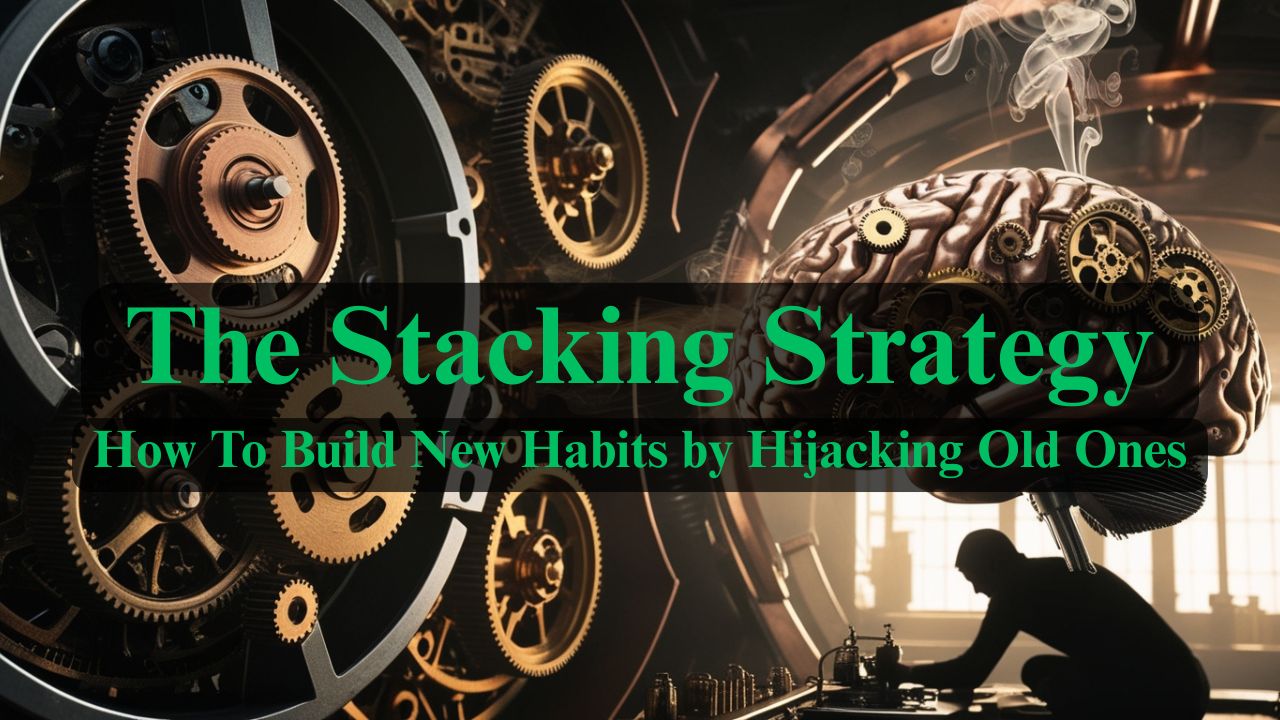
The Stacking Strategy
What if I told you that the habits you already have—even the ones you consider "bad"—could become the secret weapons for building the habits you want?
Read Full Article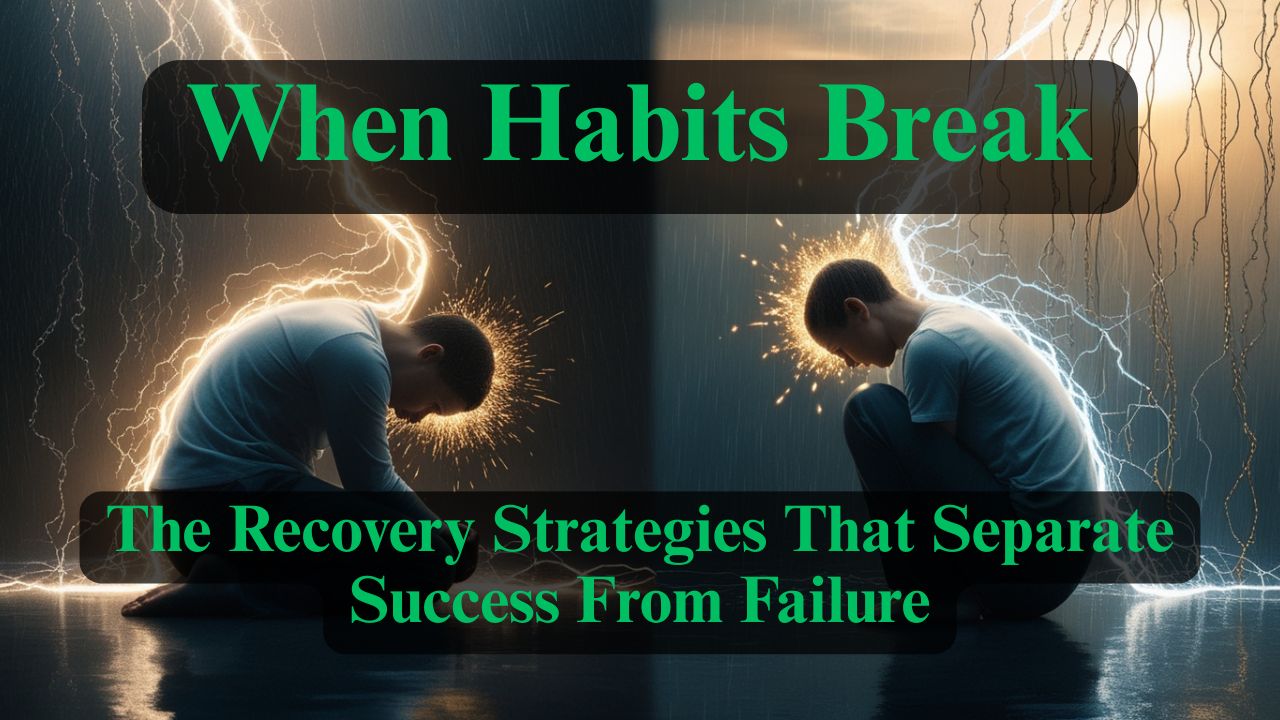
When Habits Fail - The Recovery Strategies That Separate Success From Failure
Here's what nobody tells you about building habits: you will fail. You'll miss days. You'll fall off track. You'll have weeks where everything falls apart.
Read Full Article
The Ultimate System - Designing a Life Where Good Habits Are Inevitable
You've learned to recognize habits, understand their formation timeline, stack them strategically, and recover from setbacks.
Read Full Article




